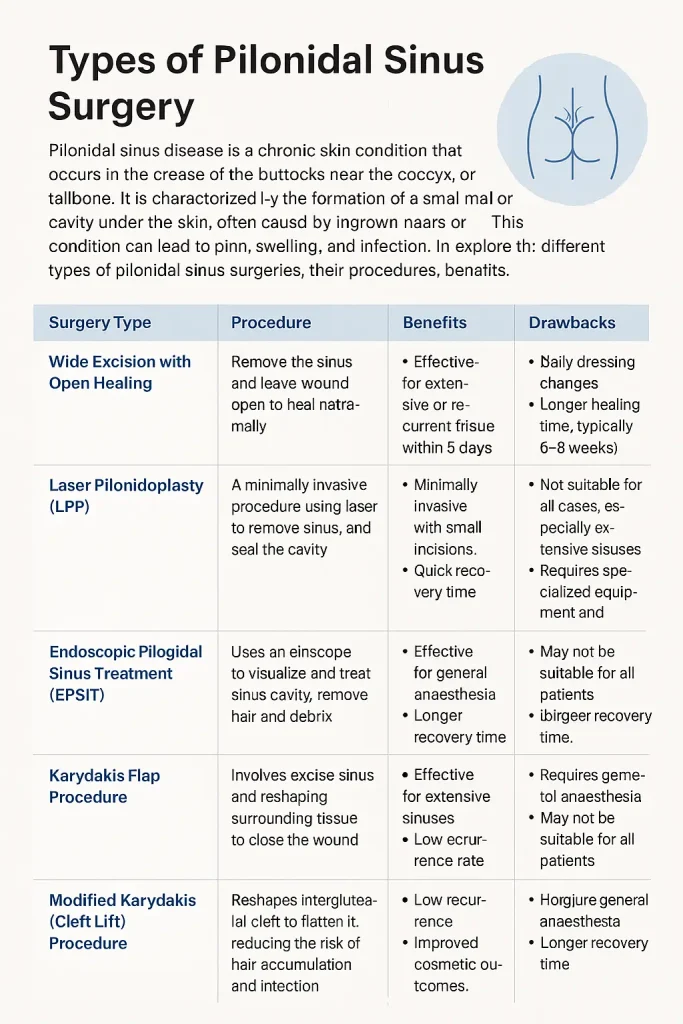Introduction
Pilonidal sinus disease is a chronic skin condition that occurs in the crease of the buttocks near the coccyx, or tailbone. It is characterised by the formation of a small tunnel or cavity under the skin, often caused by ingrown hairs or friction. This condition can lead to pain, swelling, and infection. Treatment for pilonidal sinus disease varies depending on the severity and recurrence of the condition. Surgical intervention is often necessary to alleviate symptoms and prevent further complications. In this comprehensive guide, we will explore the different types of pilonidal sinus surgeries, their procedures, benefits, and recovery times.
Types of Pilonidal Sinus Surgery
1. Wide Excision with Open Healing
Procedure:
The surgeon removes the pilonidal sinus along with the surrounding tissue, leaving the wound open to heal naturally.
Benefits:
- Effective for extensive or recurrent sinusitis.
- Allows for complete removal of infected tissue.
Drawbacks:
- Requires daily dressing changes.
- Longer healing time, typically 6–8 weeks.
- Higher risk of wound infection.
2. Laser Pilonidoplasty (LPP)
Procedure:
A minimally invasive procedure using a laser to remove the sinus tract and seal the cavity.
Benefits:
- Shorter recovery time, with patients returning to routine activities within 5 days.
- Minimal scarring.
- Low recurrence rate.
Drawbacks:
- Not suitable for all cases, especially extensive sinuses.
- Requires specialised equipment and expertise.
3. Endoscopic Pilonidal Sinus Treatment (EPSiT)
Procedure:
Utilises an endoscope to visualise and treat the sinus cavity, removing hair and debris.
Benefits:
- Minimally invasive with small incisions.
- Quick recovery time.
- Reduced risk of recurrence.
Drawbacks:
- Not suitable for large or complex sinuses.
- Requires specialised equipment and training.
4. Karydakis Flap Procedure
Procedure:
Involves excising the sinus and reshaping the surrounding tissue to close the wound.
Benefits:
- Low recurrence rate.
- Reduces tension on the wound.
- Faster healing compared to wide excision.
Drawbacks:
- Requires general anaesthesia.
- It may not be suitable for all patients.
5. Limberg Flap Reconstruction
Procedure:
Removes the sinus and surrounding tissue, followed by the rotation of a rhomboid-shaped flap of skin to cover the wound.
Benefits:
- Effective for extensive sinuses.
- Low recurrence rate.
- Good cosmetic outcomes.
Drawbacks:
- Requires general anaesthesia.
- Longer recovery time.
6. Z-Plasty
Procedure:
Involves creating triangular flaps of skin and repositioning them to close the wound.
Benefits:
- Improves the aesthetic appearance of the scar.
- Reduces tension on the wound.
Drawbacks:
- Higher risk of recurrence.
- Requires general anaesthesia.
- Longer recovery time.
7. Modified Karydakis (Cleft Lift) Procedure
Procedure:
Reshapes the intergluteal cleft to flatten it, reducing the risk of hair accumulation and infection.
Benefits:
- Low recurrence rate.
- Improved cosmetic outcomes.
- Suitable for patients with deep intergluteal clefts.
Drawbacks:
- Requires general anaesthesia.
- Longer recovery time.

Comparison Table of Pilonidal Sinus Surgery Types
| Surgery Type | Invasiveness | Recovery Time | Recurrence Rate | Best Suited For |
|---|---|---|---|---|
| Wide Excision (Open Healing) | High | 6–8 weeks | Moderate | Extensive or infected sinuses |
| Laser Pilonidoplasty (LPP) | Low | ~5 days | Low | Small, uncomplicated sinuses |
| Endoscopic Pilonidal Sinus Treatment (EPSiT) | Low | 1–2 weeks | Low | First-time or recurrent simple sinuses |
| Karydakis Flap Procedure | Moderate | 4–6 weeks | Very Low | Complex, deep sinuses or recurrences |
| Limberg Flap Reconstruction | High | 6–8 weeks | Low | Large, persistent sinuses |
| Z-Plasty | Moderate | 4–6 weeks | High | Superficial sinuses, cosmetic concern |
| Modified Karydakis (Cleft Lift) | Moderate | 4–6 weeks | Very Low | Deep natal cleft, multiple recurrences |
Factors Influencing the Choice of Pilonidal Sinus Surgery Types
When determining the most appropriate surgical intervention for pilonidal sinus disease, several factors come into play:
1. Severity of the Condition
- Extensive or recurrent cases often require more complex flap procedures like Limberg or Karydakis.
- First-time, mild cases may be managed with laser pilonidoplasty or EPSiT.
2. Presence of Infection or Abscess
- Acute infections may need to be treated with antibiotics or drainage before surgery.
- Chronic infected tracts may benefit from complete excision with open healing or flap surgery.
3. Patient’s General Health
- Minimally invasive procedures are preferred for patients with comorbidities or those unfit for general anaesthesia.
4. Cosmetic Concerns
- Surgeries like Z-plasty or cleft lift are often chosen for patients who prioritise aesthetic results.
5. Surgeon Expertise and Equipment Availability
- Techniques like EPSiT and laser pilonidoplasty require advanced tools and specialised training, limiting their availability in some areas.
Postoperative Care and Recovery Tips
Regardless of the pilonidal sinus surgery type chosen, proper postoperative care is crucial for recovery and prevention of recurrence.
Key Recovery Tips:
- Keep the Area Clean and Dry: Moisture can cause infection or delay healing.
- Avoid Prolonged Sitting: Especially on hard surfaces; consider using a cushion.
- Shave or Use Hair Removal Cream: To prevent hair from re-entering the wound.
- Follow-up Appointments: Ensure the wound is healing properly and catch early signs of recurrence.
- Wear Loose Clothing: Prevents friction and allows for better airflow.
Risks and Complications
All types of pilonidal sinus surgery come with potential risks. These may include:
- Infection: More common with open wound healing.
- Bleeding: Especially in more invasive procedures.
- Wound Breakdown or Dehiscence: Poor wound closure can lead to delayed healing.
- Recurrence: Depending on the surgical method, recurrence rates vary from 3% to over 30%.
Note: Recurrence is most effectively minimised with proper hygiene and surgical techniques that flatten or off-midline the gluteal cleft.
Latest Advances in Pilonidal Sinus Surgery Types
Recent years have seen innovations in the surgical treatment of pilonidal sinus, focusing on:
- Minimally Invasive Techniques: EPSiT and laser treatments offer quicker recovery and better patient satisfaction.
- Outpatient Surgeries: Many procedures can now be done under local anaesthesia with same-day discharge.
- Biodegradable Implants: Used to promote wound healing and reduce the need for dressing changes.
These advances aim to enhance patient outcomes and reduce the emotional and physical toll of long recoveries.
Pilonidal Sinus Surgery Types: When to See a Specialist
It’s essential to consult a colorectal or general surgeon when:
- Symptoms like pain, redness, and pus persist or worsen.
- Over-the-counter remedies and antibiotics do not help.
- There are signs of recurrence after previous surgery.
- The condition interferes with daily life, work, or physical activity.
Getting early medical advice ensures a broader choice of treatment options, including minimally invasive ones.
Frequently Asked Questions (FAQs)
1. What is the most effective type of pilonidal sinus surgery?
The Karydakis and Limberg flap procedures have the lowest recurrence rates and are highly effective for complex or recurrent cases.
2. Is pilonidal sinus surgery painful?
Pain levels vary. Minimally invasive methods like EPSiT and laser pilonidoplasty result in much less discomfort compared to wide excision.
3. How long does it take to recover from pilonidal sinus surgery?
Recovery can range from 5 days (laser) to 8 weeks (wide excision), depending on the method used.
4. Can a pilonidal sinus return after surgery?
Yes, but recurrence can be minimised through effective surgery, good hygiene, and hair removal practices.
5. Are there non-surgical treatments for pilonidal sinus?
While some acute cases can be managed temporarily with antibiotics or drainage, surgery is the only definitive cure for chronic or recurrent pilonidal disease.
Conclusion
Choosing the right pilonidal sinus surgery type is crucial for long-term relief and reduced recurrence. From traditional wide excision to advanced minimally invasive options like laser pilonidoplasty and EPSiT, each method offers distinct benefits depending on the severity of the condition and patient needs.
For those located in or near Mumbai, effective and personalised Pilonidal Sinus Treatment in Chembur is available at Kolekar Hospital. Our experienced surgical team specialises in modern techniques, ensuring minimal downtime, precise care, and a focus on recurrence prevention.
![]()



